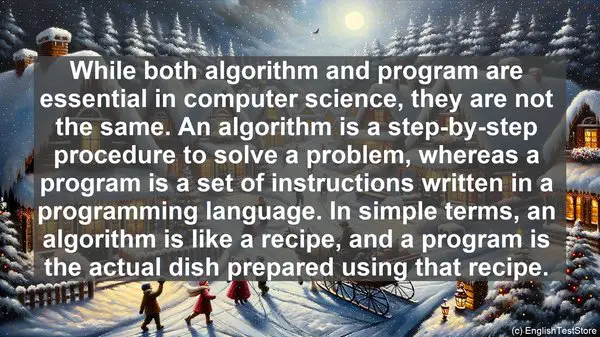Introduction
Hello everyone, welcome back to our computer science series. Today, we have an interesting topic to discuss – the top 10 commonly confused words in computer science. These terms often sound similar, but their meanings can be quite different. So, let’s dive in!
1. Algorithm vs. Program
While both algorithm and program are essential in computer science, they are not the same. An algorithm is a step-by-step procedure to solve a problem, whereas a program is a set of instructions written in a programming language. In simple terms, an algorithm is like a recipe, and a program is the actual dish prepared using that recipe.

2. Variable vs. Constant
In programming, a variable is a named storage location that can hold a value, and this value can change during program execution. On the other hand, a constant is a value that remains the same throughout the program. It’s like a fixed piece of information that doesn’t change.
3. Compiler vs. Interpreter
Both compiler and interpreter are used to convert high-level programming languages to machine code, but they do it in different ways. A compiler translates the entire program at once, generating an executable file. In contrast, an interpreter translates the program line by line, executing it immediately. It’s like the difference between reading a book from start to finish (compiler) and reading it page by page (interpreter).
4. RAM vs. ROM
RAM and ROM are both types of computer memory, but they serve different purposes. RAM (Random Access Memory) is the temporary storage area that the computer uses to store data and instructions while it’s running. It’s like the computer’s working memory. On the other hand, ROM (Read-Only Memory) contains permanent instructions that are stored during manufacturing. It’s like the computer’s built-in memory that can’t be changed.
5. Bit vs. Byte
In the world of digital data, a bit is the smallest unit of information. It can have two values – 0 or 1, representing off or on. A byte, on the other hand, is a group of 8 bits. It’s like a small container that can hold more information than a single bit. When you see file sizes, they are usually measured in bytes, like kilobytes (KB) or megabytes (MB).
6. HTTP vs. HTTPS
You might have noticed that some websites start with ‘http://’ while others start with ‘https://’. The ‘http’ stands for Hypertext Transfer Protocol, which is a protocol for transferring data between a web server and a web browser. It’s the standard way of communication. The ‘s’ in ‘https’ stands for Secure, indicating that the data transfer is encrypted, providing an extra layer of security. So, ‘https’ is the more secure version.
7. API vs. SDK
API (Application Programming Interface) and SDK (Software Development Kit) are both tools used in software development. An API is a set of rules and protocols that allows different software applications to communicate with each other. It’s like a language that they understand. On the other hand, an SDK is a collection of software tools, libraries, and documentation that helps developers build applications for a specific platform. It’s like a toolbox that provides everything you need to create something.
8. Firewall vs. Antivirus
Firewall and antivirus are two different layers of protection in computer security. A firewall is a barrier that monitors and controls incoming and outgoing network traffic. It’s like a gatekeeper that decides who can enter or leave. An antivirus, on the other hand, is a software that scans for and removes viruses, malware, and other malicious programs. It’s like a security guard that checks for any threats within the system.
9. LAN vs. WAN
LAN (Local Area Network) and WAN (Wide Area Network) are two types of computer networks. A LAN is a network that connects devices within a limited area, like a home, office, or school. It’s like a small community where devices can easily communicate with each other. On the other hand, a WAN is a network that covers a larger geographical area, like connecting multiple offices in different cities. It’s like a network of networks, bringing different communities together.

10. Bug vs. Error
In software development, a bug and an error are not the same, although they both indicate something is not working as expected. A bug refers to a flaw or defect in the code, which may cause the program to behave incorrectly. It’s like a mistake in the instructions. An error, on the other hand, is a deviation from the expected result. It’s like the outcome not matching what was anticipated. So, a bug can lead to an error, but not all errors are caused by bugs.
